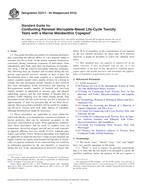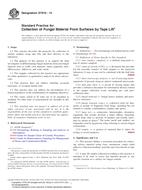Potrebujeme váš súhlas na využitie jednotlivých dát, aby sa vám okrem iného mohli ukazovať informácie týkajúce sa vašich záujmov. Súhlas udelíte kliknutím na tlačidlo „OK“.
ASTM E2317-04(2012)
Standard Guide for Conducting Renewal Microplate-Based Life-Cycle Toxicity Tests with a Marine Meiobenthic Copepod (Withdrawn 2021)
Automaticky preložený názov:
Štandardné príručka pre Prevedenie obnovu mikrotitračnıch Skúšky životného cyklu, Toxicity s Marine Meiobenthic buchanky
NORMA vydaná dňa 1.12.2012
Informácie o norme:
Označenie normy: ASTM E2317-04(2012)
Poznámka: NEPLATNÁ
Dátum vydania normy: 1.12.2012
Kód tovaru: NS-45021
Počet strán: 16
Približná hmotnosť: 48 g (0.11 libier)
Krajina: Americká technická norma
Kategória: Technické normy ASTM
Kategórie - podobné normy:
Anotácia textu normy ASTM E2317-04(2012) :
Keywords:
ICS Number Code 07.100.99 (Other standards related to microbiology)
Doplňujúce informácie
| Significance and Use | ||||||||||||||||
|
5.1 Protection of a species requires prevention of unacceptable effects on the number, health, and uses of individuals of that species. A life-cycle toxicity test is conducted to determine changes in the numbers of individuals and offspring of a test species resulting from effects of the test material on survival, growth, gender ratios, endocrine function, genetic expression, fertility and reproduction (1-3).3 Information might also be obtained on effects of the material on the health 5.2 Published information about the sensitivities of several meiobenthic copepods to several common metals and organic toxicants have been reviewed (5). For most compounds tested/published to date, 5.3 Results of life-cycle tests with 5.4 Results of life-cycle tests with 5.5 Results of life-cycle tests with 5.6 Results of a life-cycle test with 5.7 Results of life-cycle tests with 5.8 Results of life-cycle tests with 5.9 Life-cycle tests with 1.1 This guide describes procedures for obtaining laboratory data concerning the adverse effects of a test material added to seawater, but not to food, on the marine copepod Amphiascus tenuiremis , during continuous exposures of individuals, from immediately after birth, until after the beginning of reproduction using a 200 μL renewal microplate-culturing technique. The following data are checked and recorded during the test period: stage-specific survival, number of days it takes for development from a first stage nauplius to a reproductively mature copepod, gender ratios, number of days for a female to extrude first and subsequent broods, number of days between first (and subsequent) brood extrusion(s) and hatching of first-generation nauplii, number of hatched and surviving nauplii, number of unhatched or necrotic eggs and aborted unhatching eggsacs, and the total number of females able to produce viable offspring over the entire mating period. This microplate-based full life-cycle toxicity test has a duration of approximately 17 days for toxicants that do not delay development. These procedures probably will be useful for conducting life-cycle toxicity tests with other species of copepods, although modifications might be necessary. 1.2 These procedures are applicable to most chemicals, either individually, or in formulations, commercial products, or known mixtures, that can be measured accurately at the necessary concentration in water. With appropriate modifications these procedures can be used to conduct tests on temperature, dissolved oxygen, and pH and on such materials as aqueous effluents (see also Guide E1192), sediment pore waters, and surface waters. Renewal microplate tests might not be applicable to materials that have a high oxygen demand, are highly volatile, are rapidly transformed (biologically or chemically) in aqueous solutions, or are removed from test solutions in substantial quantities by the test chambers or organisms during the test. If the concentration of dissolved oxygen falls below 50 % of saturation, or the concentration of test material in the test solution decreases by more than 20 % between renewals, it might be desirable to renew the solutions more often. 1.3 This standard does not purport to address all of the safety concerns, if any, associated with its use. It is the responsibility of the user of this standard to establish appropriate safety and health practices and determine the applicability of regulatory requirements prior to use. |
||||||||||||||||
| 2. Referenced Documents | ||||||||||||||||
|
Podobné normy:
Historická
1.9.2012
Historická
1.6.2014
Historická
1.10.2009
Historická
1.3.2009
Historická
1.4.2008
Historická
1.7.2013
Odporúčame:
Aktualizácia technických noriem
Chcete mať istotu, že používate len platné technické normy?
Ponúkame Vám riešenie, ktoré Vám zaistí mesačný prehľad o aktuálnosti noriem, ktoré používate.
Chcete vedieť viac informácií ? Pozrite sa na túto stránku.



 ASTM D7819-12
ASTM D7819-12 ASTM D7910-14
ASTM D7910-14 ASTM E1428-99(2009)..
ASTM E1428-99(2009).. ASTM E1963-09
ASTM E1963-09 ASTM E2315-03(2008)..
ASTM E2315-03(2008).. ASTM E2564-13
ASTM E2564-13
 Cookies
Cookies
